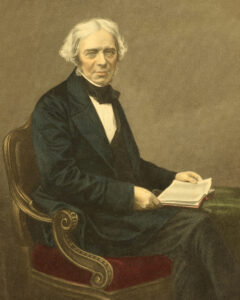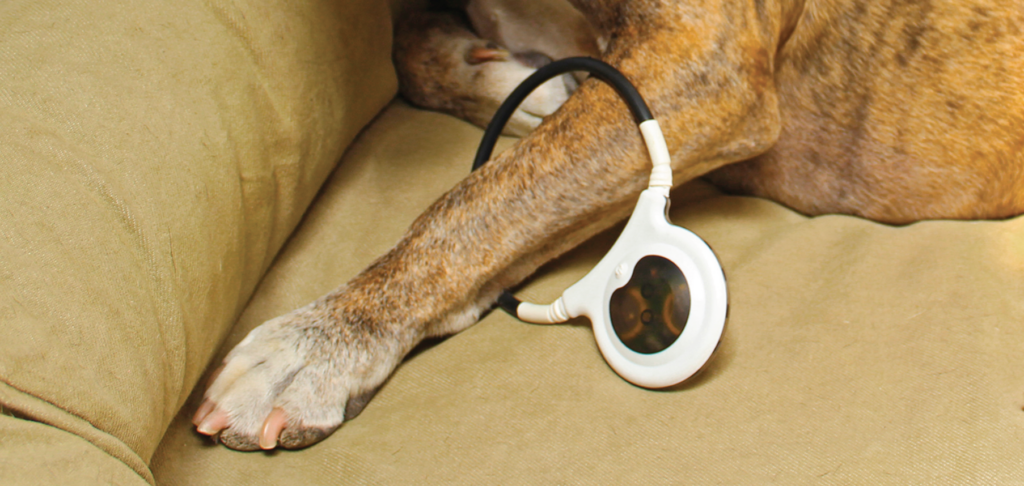
Understanding Targeted PEMF™ Technology
Time-tested, Transformative Therapy for Improving Animal Health
What is Targeted Pulsed Electromagnetic Field (tPEMFTM) Therapy?

The practice of Pulsed Electromagnetic Field (PEMF) therapy is not new to the medical world. Devices like bone growth stimulators have been available as FDA-cleared devices since the 1970’s. These devices use PEMF signals that are “tuned” to target bones and increase healing in non-healing fractures.
Targeted Pulsed Electromagnetic Field (tPEMF™) therapy delivers a micro-current to damaged tissue that is precisely tuned to trigger an animal’s own natural anti-inflammatory process. The electromagnetic signal, which is one-one-thousandth the strength of a cell phone, stimulates cellular repair by upregulating the body’s own production of endogenous nitric oxide (NO).
The biological effect of that induced current is the functional therapeutic component of tPEMF technology. Enhancing nitric oxide, the body’s own anti-inflammatory molecule, has several biotherapeutic effects depending on the target tissue and the specific characteristics of the tPEMF waveform used.

Bring the Healing Home
The Assisi LOOP’s specific waveform is tuned to accelerate healing while lowering inflammation, pain, and swelling. It is a safe, effective, non-invasive, non-pharmaceutical therapy using the same technology that has been FDA-cleared for human use. Learn more about the Assisi tPEMF signal’s Mechanism of Action.
More recently, a second tPEMF signal has been developed, targeted to create a biological effect on the brain’s neural tissue. The patent-pending Calmer Canine® waveform targets the stress and anxiety centers in the brain, effectively reducing anxiety and restoring the animal to a calmer, more emotionally balanced state.
Learn more about our research.
Read more about the Calmer Canine Mechanism of Action.
The History of tPEMF Technology
Michael Faraday, a British chemist and physicist, discovers electromagnetic induction. The basic law of induction postulated by Faraday is later named “Faraday’s Law,” 1 (1831)
Tesla publishes “The Electrical Engineer” and discusses invention of magnetic loop coil, still used today; led to magnetic strength being measured in Teslas (T).2 (1898)
Arthur A. Pilla, PhD develops a relatively low-powered PEMF device – a bone growth stimulator (BGS) – to heal recalcitrant factures.4 (1970)
FDA approves PEMF for the healing of nonunion fractures.5 (1979)
The Assisi LOOP’s patented signal targeting the upregulation of nitric oxide was developed by the late Dr. Arthur Pilla of Columbia University and cleared by the FDA for treating non-healing fractures.6 (1979)
FDA approves PEMF for urinary incontinence and muscle stimulation7
The Nobel Prize for Medicine and Physiology was awarded to three American pharmacologists: Robert F. Furchgott, Louis J. Ignarro and Ferrid Murad for their work on nitric oxide as a signaling molecule in the cardiovascular system.8
Assisi Animal Health is born, founded by incorporating Dr. Pilla’s technology, cleared by the FDA for human medicine, into their portfolio of products for animal health.
The Assisi LOOP® received its FDA clearance for its PEMF signal that reduces pain and edema. The science that inspired the Assisi LOOP’s design and treatment regimen is described below.11
Under new management, Assisi Animal Health increased their focus on validating PEMF technology through clinical research.
A clinical trial found that using tPEMF therapy on dogs with spinal injuries resulted in reduced incisional pain, improved neuroprotective qualities, and a statistically greater degree of recovery of proprioception.13
Assisi Animal Health unveils its new line of Calmer Canine® products, which employs a unique tPEMF signal, reducing inflammation in the anxiety center of the brain.
A trial published in the Journal of the American Animal Hospital Association found that using the Assisi Loop to treat dogs with intervertebral disc disease resulted in improved wound healing, a 50% reduction in opioid administration, and zero side effects.14
Timeline Citations
- Al-Khalili, J. The birth of the electric machines: a commentary on Faraday (1832) ‘Experimental researches in electricity’. Philos Trans A Math Phys Eng Scie.,20015 April 13; 373(2039):20140208.
- Nikola Tesla. http://web.mit.edu/most/Public/Tesla1/etradict.htm. Last accessed 11/10/20.
- Strauch, B., et al. Mar 2009. Evidence-Based use of Pulsed Electromagnetic Field Therapy in Clinical Plastic Surgery. Aesthetic Surgery J, v29(2); 135-143.
- Oct 2015. Pilla, A. https://www.bems.org/node/15190#:~:text=Dr.-,Arthur%20A.,He%20was%2080%20years%20old. Last accessed 11/10/20.
- Reclassification of Non-Invasive Bone Growth Stimulators, FDA Executive Summary.
- Gaynor, et al. 2018. Veterinary applications of pulsed electromagnetic field therapy, Res. Vet. Sci., 119; 1-8.
- Quek, P. 2005. A critical review on magnetic stimulation: What is its role in the management of pelvic floor disorders?. Curr Opin Urol. 15(4); 231-5.
- SoRelle, R. 1998. Nobel prize awarded to scientist for nitric oxide discoveries. J. Am. Heart Assoc., 98;2365-2366.
- Coric, et al. 2018. Pulsed electromagnetic field stimulation may improve fusion rates in cervical arthrodesis in high-risk populations. Bone Jt. Res., 7(2); 124-130.
- Transcranial Magnetic Stimulation (TMS). https://adaa.org/finding-help/transcranial-magnetic-stimulation. Last accessed 11/10/20.
- Strauch, et al. 2009. Evidence-Based use of pulsed electromagnetic field therapy in clinical plastic surgery. Aesthet. Surg. J., 29(2); 135-143.
- Vadalà, et al. 2016. Mechanisms and therapeutic effectiveness of pulsed electromagnetic field therapy in oncology. Cancer Med., 5(11); 3128-3139.
- Zidan, et al. 2018. The Effect of Electromagnetic Fields on Post-Operative Pain and Locomotor Recovery in Dogs with Acute, Severe Thoracolumbar Intervertebral Disc Extrusion: A Randomized Placebo-Controlled, Prospective Clinical Trial. J. Neurotrauma, 35(15); 1726-1736.
- Alvarez, et al. 2019. Effect of targeted pulsed electromagnetic field therapy on canine postoperative hemilaminectomy: a double-blind, randomized, placebo-controlled clinical trial. J Am Anim Hosp Assoc., 55(2); 83-91.




